Since the 2020 pandemic, poor mental health has been on the rise. 1 in 3 adults said their mental health has declined compared to pre-pandemic levels.
It’s now suggested that 1 in 5 people in England are living with a common mental health problem. But, while so many suffer, funding and mental health services are still limited, with long wait times and limited treatment options.
The stigma around many mental health conditions remains and many aren’t able to get the help they need.
On this page, we’ve outlined UK-focused statistics of some of the most common mental health conditions.
In this article, you’ll find statistics for:
- Depression
- Anxiety
- Mental health trends
- Workplace mental health
- Loneliness
- OCD
- Borderline personality disorder
- ADHD
- Sleep
- Bipolar
- Schizophrenia
- Seasonal affective disorder
- PTSD and trauma
- Stress
- Self-harm and suicidal feelings
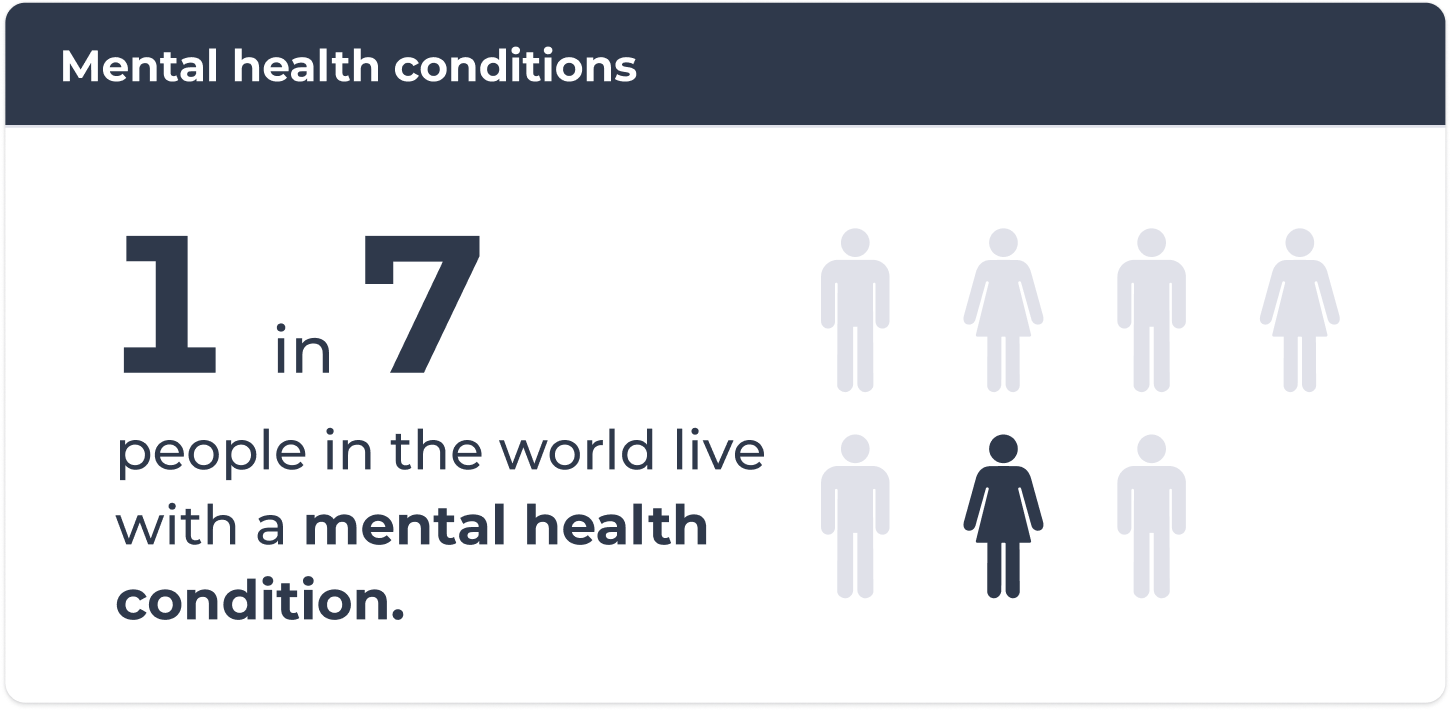
Depression
- Women are more likely (19%) than men (14%) to report experiencing depression.
- 15% of women receive treatment for depression, compared to 9% of men.
- Adults aged 16 to 29 years are most likely to experience some form of depression (28%) in the UK.
- More than 332 million people suffer from depression worldwide, an estimated 5.7% of adults.
- In high-income countries, only about one third of people with depression receive mental health treatment.
Source: WHO
- In England, only 25.4% of respondents believed someone with depression would be just as likely to be promoted after repeated absences, compared to 60.1% for diabetes.
Source: MIND

Anxiety
- In any given week in England, 6 in 100 people are diagnosed with Generalised Anxiety Disorder.
- Anxiety is a highly treatable disorder but only 27.6% receive treatment.
- Women are twice as likely to be affected by panic disorders than men.
- 5.6% of people in the UK are estimated to have an anxiety disorder, higher than the 4.4% global average.
Source: Priory
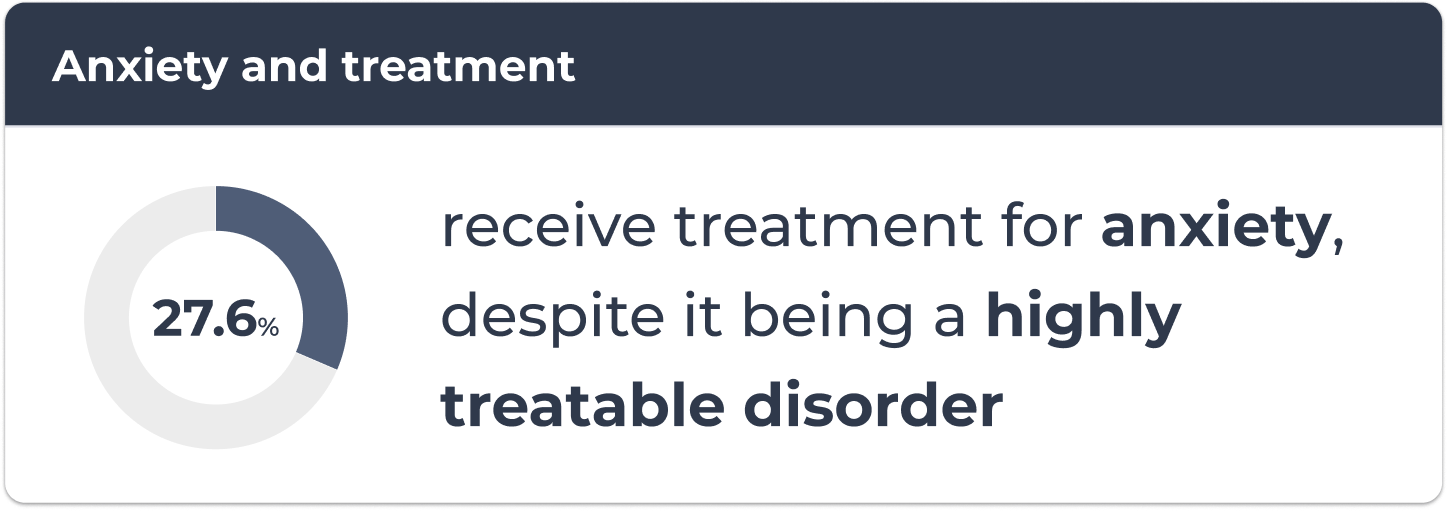

Mental health trends
- 1 in 4 people will experience a mental health problem of some kind each year in England.
- 1 in 5 people experience a mental health issue, such as anxiety and depression, in any given week in England.
- Nearly 1 in 4 women (24%) experience a common mental health problem in any given week, compared to nearly 1 in 7 men (15%).
Source: Mind
Children:
- In 2023, 1 in 5 (aged 8–25) reported living with a probable mental health problem - a sharp and troubling rise from 1 in 9 (aged 7–16) in 2017.
- Among 17–25-year-olds, nearly 1 in 3 young women (31%) had a probable mental health problem, compared to 15% of young men aged 17–19 and 13% aged 20–25.
- Eating difficulties are also on the rise among young people in England, with 1 in 8 aged 17–19 having reported experiencing an eating problem or disorder.
- Young women are 4 times more likely than young men to be affected by eating disorders.
- Of the known primary referral reasons for children’s mental health issues, anxiety was the most common (16% - up slightly from 15% in 2022-23), followed by neurodevelopmental conditions excluding autism (11% - up from 9.2%), suspected autism (6.8% - up from 5.3%) and ‘in crisis’ (6.2% - up from 5.8%).
- Since last year, the number of children being referred for neurodevelopmental conditions has increased by almost 30%.
Source: Mind, Children’s Commissioner
Waiting times:
- People are eight times more likely to wait over 18 months for mental health treatment than physical health treatment.
- Those facing the longest waits for mental health care are now waiting nearly two years (658 days), more than twice as long as those needing elective physical health treatment (299 days).
Source: Rethink
Workplace mental health
- ¼ of people say that work has a negative impact on both their mental and physical health, this equates to 8 million employees in the UK.
- Hybrid working correlates significantly more strongly with positive perceptions of mental health (66% rate their mental health as good).
- Average absence levels have increased to 9.4 days per employee per year, compared with 7.8 days in 2023 and 5.8 days in 2022.
- Mental ill health is the top cause of long-term absence (41% of respondents citing it within top three causes) and minor illnesses by far the main reason for short-term absence (78%).
- The proportion of organisations with a stand-alone wellbeing strategy has increased from 44% in 2020 to 57% in 2025.
- Heavy workloads stand out as the top cause of stress-related absence (41% of those organisations reporting stress-related absence).
Source: CIPD Report


- Mental ill health is now the most common cause of work-limiting conditions among those aged 44 years and younger.
- It is estimated that 15% of UK workers have an existing mental health condition.
Source: MentalHealth.org
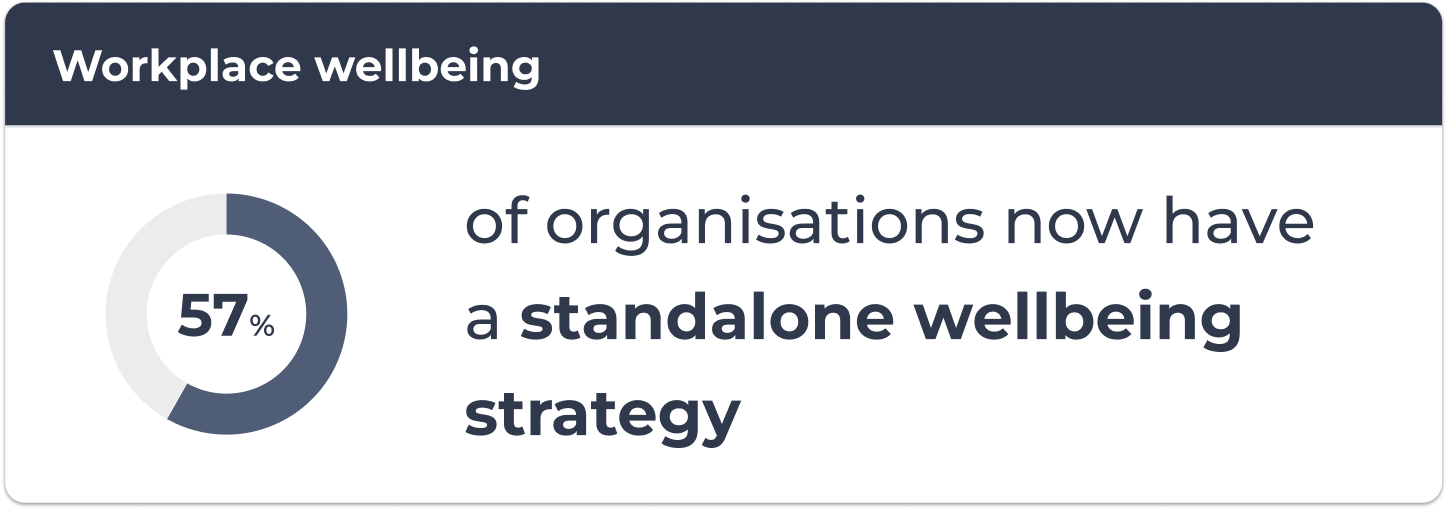
- There was a 4% rise in the likelihood of younger generations (those aged 18–24, 25–34 and 35–44) saying they had needed to take time off due to poor mental health caused by pressure and stress.
- 91% of UK adults reporting that they experienced high or extreme levels of pressure or stress in the past year.
- Almost 3 in 10 (28%) people aged 18–24 had to take time off work due to health challenges while waiting for NHS treatment (increasing to 9% of those aged 55+).
- Less than one-third of UK workers (29%) say they feel fulfilled at work.
- 1 in 5 workers (21%) needed to take time off work due to poor mental health caused by pressure or stress in the past year, compared to 20% of workers in 2024.
Source: Mental Health UK Burnout Report

Loneliness
- 1 in 4 adults (24%) reported feeling lonely "often, always or some of the time".
- Feeling lonely "often, always or some of the time" increased to over half (55%) among adults experiencing moderate to severe depressive symptoms, around three times more likely than those with no or mild symptoms (16%).
- Younger adults, and adults experiencing moderate to severe depressive symptoms, reported feeling lonely more often (31%).
Source: OPN Survey
- 1 in 6 people worldwide is affected by loneliness, with significant impacts on health and well-being.
- Loneliness and isolation was connected to an estimated 100 deaths every hour and more than 871,000 deaths each year.
Source: WHO

Obsessive compulsive disorder - OCD
- About 370,000 young people in England reported OCD symptoms in the financial year 2023/24.
- This is more than three times the number from 2014, when the figure stood at around 113,000.
- OCD is now second in the list of named mental health disorders - placing it and other anxiety disorders well ahead of depression (GAD 7.6%, OCD 5.7%).
Source: BBC
- Between 1-2% of the population in the UK have OCD.
- People with OCD experience repetitive and intrusive thoughts, and obsessions.
- There is currently the stigma that OCD is mild and quirky.
- Misconception that OCD simply means excessive hand-washing.
- Half the adults who have OCD, got it as a child but didn’t seek help due to embarrassment or stigma.
- Out of 500 young children, 5 will have OCD.
- Women are 3x more likely to be affected than men.
Source: OCDaction

Borderline personality disorder
- BPD is a mental health condition that 0.7 - 2.0% in the general population have.
- In the UK, 1–5% of adolescents could meet the diagnostic criteria for BPD.
- The life expectancy of people within secondary mental health care with a primary diagnosis of personality disorder was found to be reduced by 17–19 years. compared with the general population of England and Wales.
- People report experiencing discrimination and stigma as a direct result of receiving a BPD diagnosis.
Source: Pharmaceutical Journal
- BPD is diagnosed in people above 18 years old, sometimes as early as 12.
- 75% of BPD sufferers are women.
- 50% of people with BPD are likely to have abused substances within the previous year.
- Individuals with this disorder make up 20% of all psychiatric inpatients.
Source: MedAlertHelp
ADHD
- Only approximately 10-20% of individuals with ADHD will be treated.
- Although there's no direct cause for ADHD, it’s thought that genetic factors are responsible for 70%-80% of the probability.
- Up to 60% of adults who have childhood ADHD will continue to show symptoms into their adult life.
- In the UK it’s thought that between 2% to 5% of school aged children have ADHD.
- 2,498,000 people in England have ADHD, including those without a diagnosis.
- Of these an estimated 741,000 are children and young people (aged 5-24).
- There has been an increase of 13.5% of referrals for ADHD assessments in the past year.
Source: NHS
- People with ADHD are much more likely to experience a mental health difficulty like anxiety or depression.
- In England, the proportion of adults screening positive for ADHD rose from 8.2% in 2007 to 13.9% in 2023–24.
- Only 1 in 5 people told their employer about their ADHD.
- The new statistics for people receiving an ADHD diagnosis prove its life changing impact: It helped people better understand themselves (84%), manage their mental health (58%), and build self-esteem (54%).
- 63% of those waiting for a diagnosis said they wanted help managing their mental health, yet few had access to it.
Source: MIND
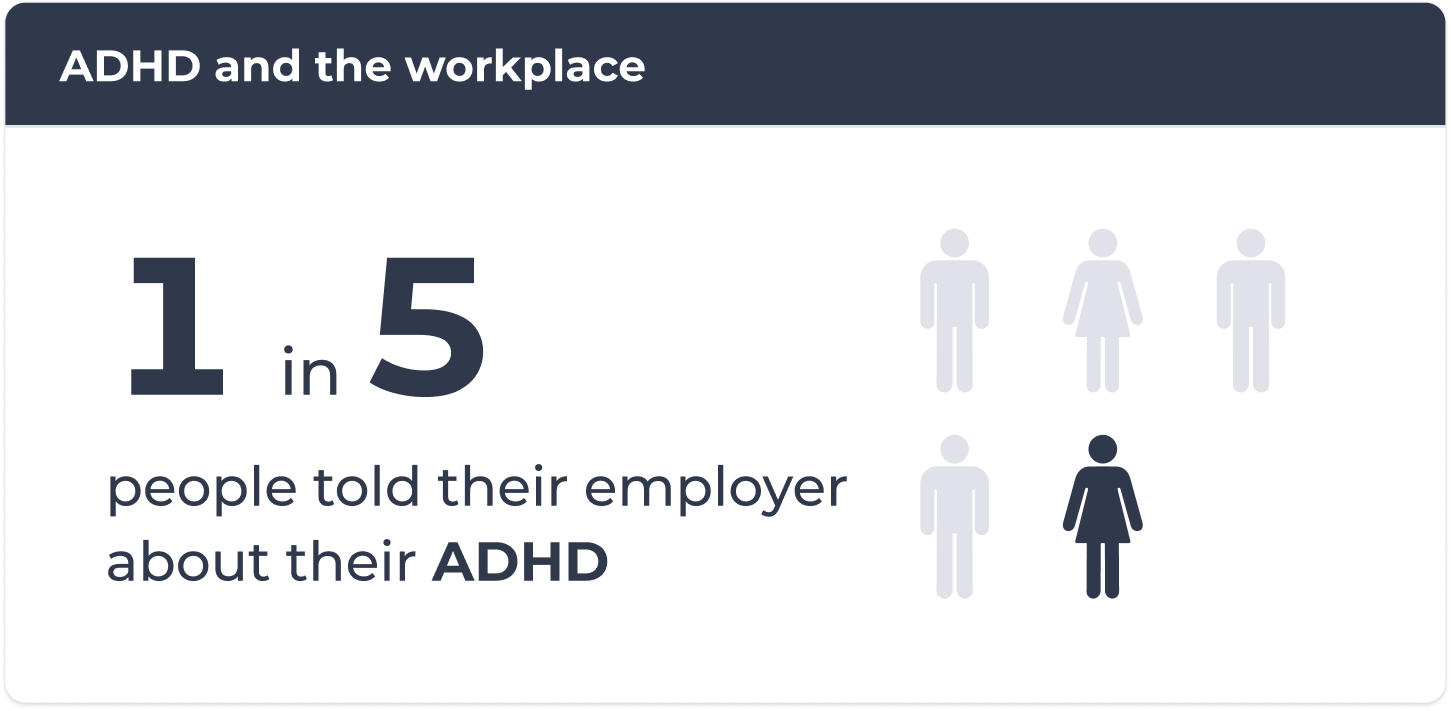

Sleep
- Almost 1 in 5 people in the UK aren’t getting enough sleep.
- 37% of adults in the UK cite work as reducing the amount of control they feel they have over their sleep.
- 66% of adolescents cite poor sleep as negatively impacting on their mental health.
- 25% of adults in the UK cite money worries as negatively impacting their sleep.
- 26% of adults in the UK cite Covid-19 as negatively impacting their sleep.
- It’s recommended that adults up to the age of 64, need 7-9 hours of sleep per night.
Source: MentalHealth.org


Bipolar
- Approximately 1.7% of adults in England had experienced bipolar disorder.
- 3.4% of UK 16–24‑year‑olds screened positive for bipolar, vs. 0.4% of UK adults aged 65–74.
- Worldwide, there were around 39.5 million prevalent cases of bipolar (approximately 0.53% of global adults), which had increased from 24.8 million in 1990.
- It's estimated that around 372,000 people are currently out of work due to bipolar disorder.
- Employment rates among those with bipolar (40-60%) are significantly lower than the general population (74% on average).
- Over 44% of people with bipolar disorder report stigma in the workplace, impacting career progression and wellbeing.
Source: Priory

Schizophrenia
- Schizophrenia affects approximately 23 million people or 1 in 345 people (0.29%) worldwide. The rate is 1 in 233 people (0.43%) among adults.
- People with schizophrenia are 2 to 3 times more likely to die early than the general population.
- Onset is most often during late adolescence and the twenties.
- Onset tends to happen earlier among men than among women.
- People with schizophrenia die nine years earlier than the general population.
- Approximately 50% of people in mental hospitals have a schizophrenia diagnosis.
- Only 29% of people with psychosis receive specialist mental health care.
Source: World Health Organization
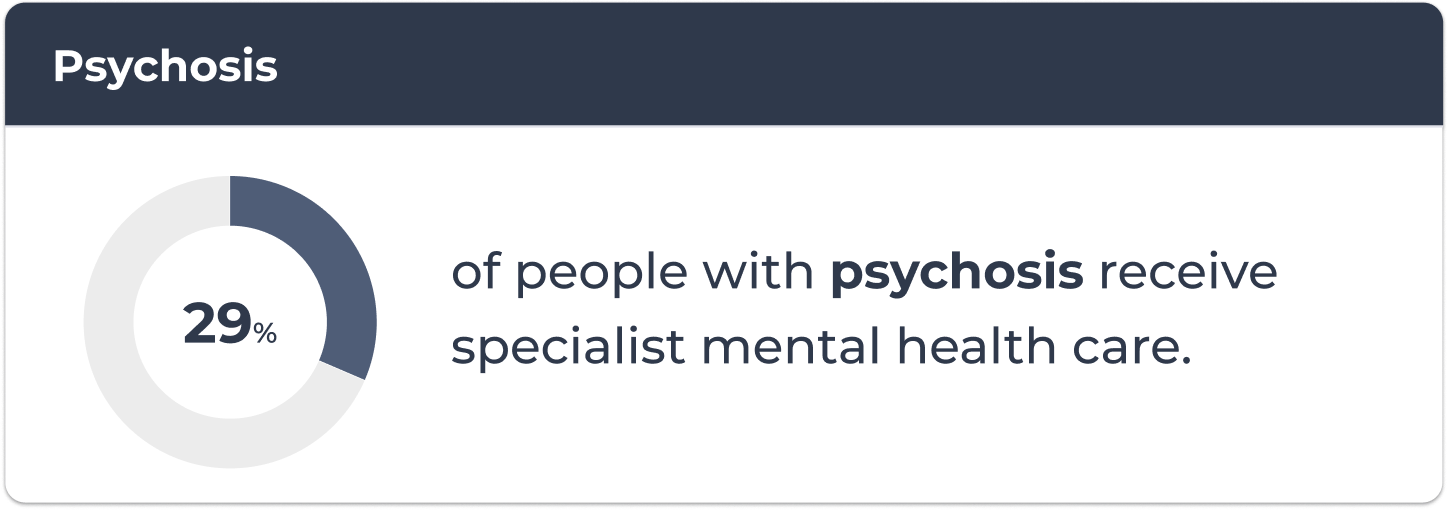

Seasonal affective disorder
- 1 in 5 are affected, though only 2% experience full SAD.
- Young people between 16 and 30 are more likely to be diagnosed with SAD, as are women.
- Between 0.5% and 2.4% of the population suffer from it: 268,000 to 1.6 million people in the UK.
- One study found women are two to three times more likely to be diagnosed with SAD.
- People living further away from the equator are also more likely to have SAD due to shorter days.
Source: Sky

PTSD and trauma
- 50-70% of people will experience a trauma at some point in their life.
- 33% of people who experience a trauma may go on to develop Post Traumatic Stress Disorder.
- 1 in 10 people in the UK are expected to experience PTSD at some point in their lives (6,665,000 people).
- 4 in 100 people in the UK are expected to have PTSD at any given time.
- Women aged 16-24 are most likely to screen positive for PTSD (12.6% of the population in this age range).
- Age 55-64 is the only age category where men were more likely to screen positive than women for PTSD.
- One in 13 children and young people in the UK will suffer from PTSD at some point during childhood.
- Risk for developing PTSD from the following traumatic events: rape (49%), severe physical assault (31.9%), car or train accident (16.8%), shooting or stabbing (15.4%).
Source: PTSD UK
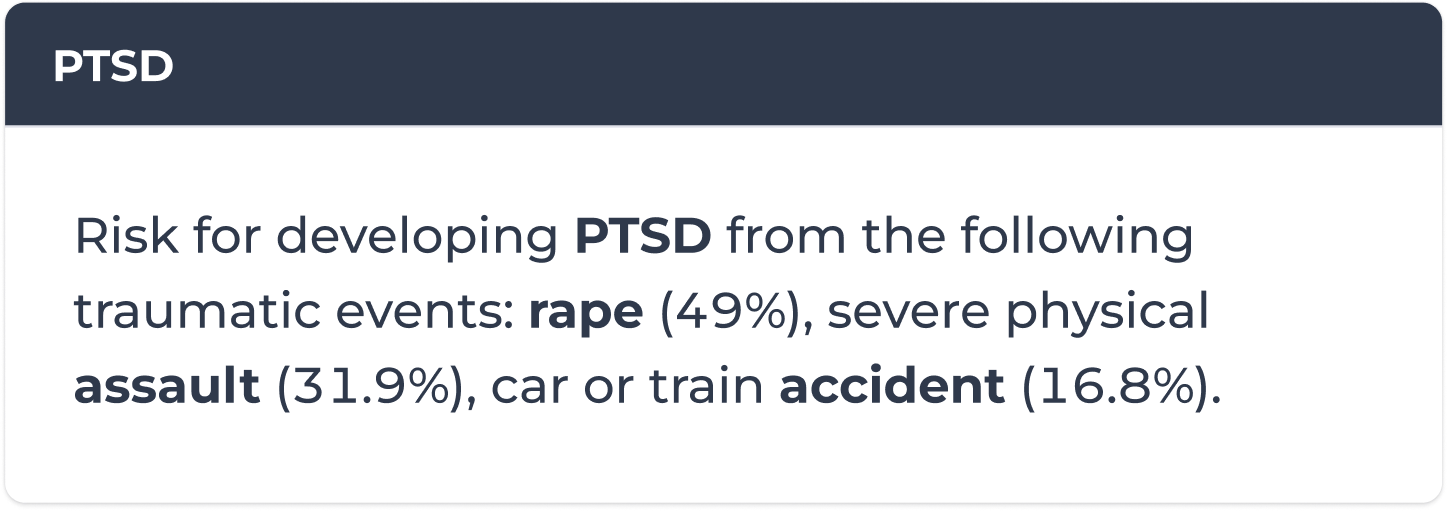
- LGBTQ people are more than twice as likely to experience PTSD than cisgender/heterosexual people, especially transgender people.
- Almost 1 in 10 (9.4%) adults living in the most deprived areas screened positive for PTSD compared to 3.9% in the least deprived areas.
- Almost 10% of adults with poor physical health screened positive for PTSD.
- 24% of people who screened positive for PTSD are receiving psychological treatment.
- The PTSD recovery rate with NHS Talking Therapies (NHS TT) is about 37.8% and 15-20% in some services – this is lower than the overall NHS TT recovery rate of 50-60% across all disorders.
- It is estimated that 27% of people who received a PTSD diagnosis in their lifetime have attempted suicide.
- Women with PTSD are almost 7 times more likely than other women to die by suicide, and men with PTSD are 4 times more likely to die by suicide than other men.
Source: Priory
Stress
- 74% of adults have felt so stressed at some point over the past year that they felt overwhelmed or unable to cope.
- 81% of women reported feeling overwhelmed or unable to cope due to stress, compared to 67% of men.
- Younger people experience higher stress related to the pressure to succeed, with 60% of 18-24-year-olds and 41% of 25-34-year-olds citing this, compared to 17% of 45-54s and 6% of over 55s.
- Stress, depression, or anxiety accounted for 46% of all work-related ill health cases and 54% of all working days lost due to ill health in 2023/24.
- 32% of working adults saying their workplace had plans in place to help colleagues spot the signs of chronic stress and prevent burnout in the past year.
- Almost a third of people (32%) had experienced suicidal thoughts or feelings because of stress.
- 60% of young people aged 18–24 have felt so stressed by the pressure to succeed that they have felt unable to cope.
Source: Priory

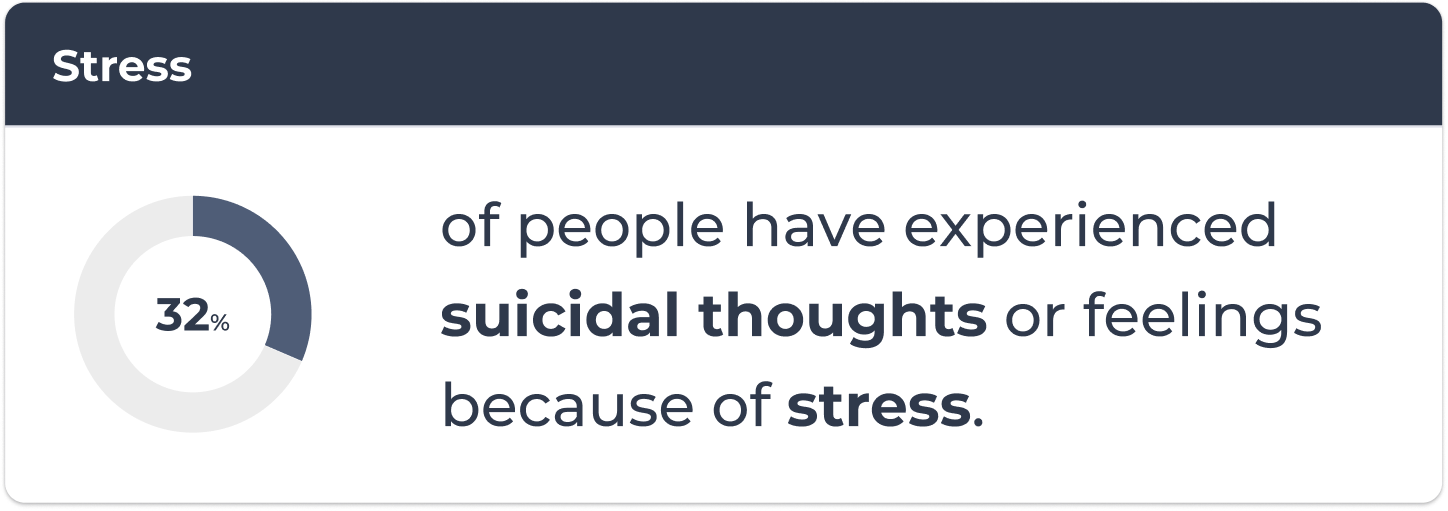
Self-harm and suicidal feelings
- There were 11.4 deaths per 100,000 people in 2023, an increase from 10.7 in 2022. This is the highest rate since 1999.
- The rate for male suicide is 17.4 deaths per 100,000.
- The rate for female suicide is 5.7 deaths per 100,000.
- The age-specific suicide rate was highest for males aged 45 to 49 years (25.5 deaths per 100,000), and for females aged 50 to 54 years (9.2 deaths per 100,000).
- London had the lowest rate of any region in England (7.3 deaths per 100,000); the highest rate was in the North West (14.7 deaths per 100,000).
Source: ONS
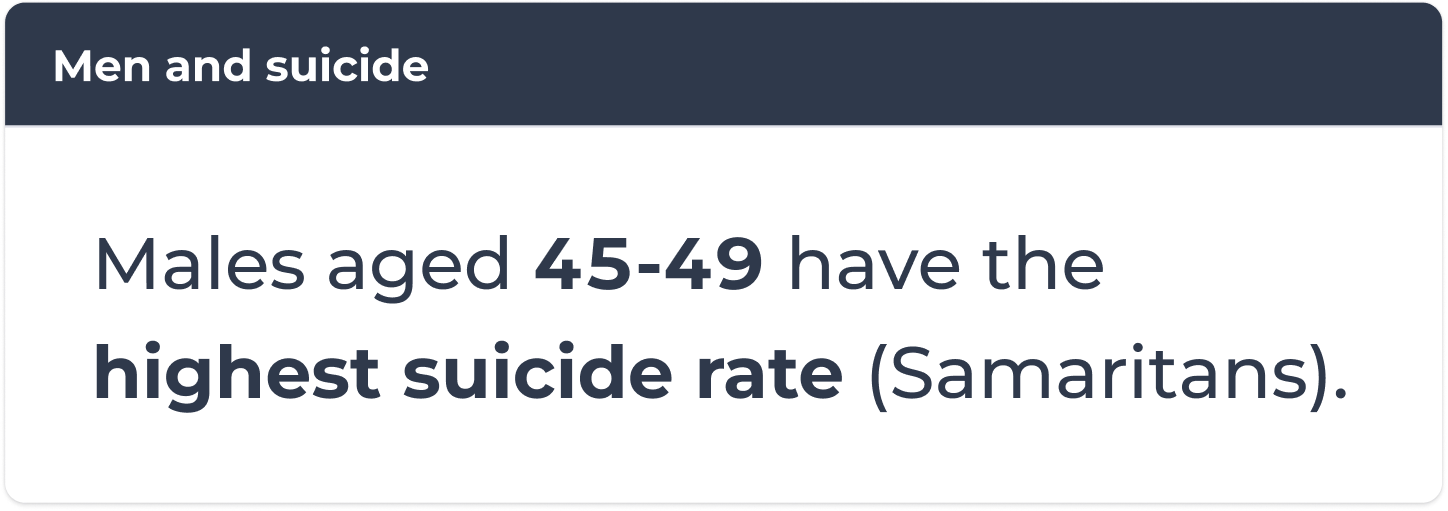
Summary
That’s a wrap on the 2025 mental health statistics. One thing stood out: people are eight times more likely to wait 18 months for mental health support than physical care.
We hope these stats spark some thought. Tell us what stood out to you - we’d love to hear what you think.


